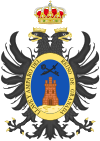Mojácar
| Mojácar municipality | ||
|---|---|---|
| coat of arms | Map of Spain | |

|
|
|
| Basic data | ||
| Autonomous Community : | Andalusia | |
| Province : | Almeria | |
| Comarca : | Levante Almeriense | |
| Coordinates | 37 ° 8 ′ N , 1 ° 51 ′ W | |
| Height : | 152 msnm | |
| Area : | 72 km² | |
| Residents : | 6,403 (Jan 1, 2019) | |
| Population density : | 88.93 inhabitants / km² | |
| Postal code : | 04638 | |
| Municipality number ( INE ): | 04064 | |
| Nearest airport : | Almeria (78 km) | |
| administration | ||
| Website : | www.mojacar.es | |
Mojácar is a coastal town in the province of Almería in southern Spain on the Mediterranean coast called Costa de Almería .
"Coat of arms"
The symbol of the city (and also of the province of Almería) is the indalo , the stick figure who holds a rainbow on his outstretched arms. The Indalo is a prehistoric fetish that was found in the cave of "Los Letreros" near Velez Blanco. It soon became customary to paint a drawing of the Indalo on the house facades to protect the residents from evil. Since then it has been considered a " totem " in the province of Almería , which protects against evil spirits, storms and other dire events. Today, however, it serves as a symbol of identification for the south-east of Spain, and this symbol is now emblazoned on almost every transporter from the province of Almería.
location
The place is on a hill of the Sierra Cabrera, about 2 km from the coast. The provincial capital Almería is 90 km away and can be reached via the A-7 , "Autovía del Mediterraneo" at the AS 520 .
History and culture
Mojácar is of Phoenician origin. The area was settled early on, the current name probably developed from “Monte Sacrum a Munsaqar”, later “Munsaqar” for short. The original location does not match the current one, with the exception of the “Alt-Mojácar” district. Until 917 the place was under the control of the young city of Murcia , from that time they were loyal to the Caliphate of Córdoba until its collapse at the beginning of the 11th century. In this century Mojácar was conquered by Almutamid from Seville . With the beginning of the rule of Muhammad I in Granada , the place with its lands fell to this sultanate, which caused the coexistence of the population, especially in the border area, many inconveniences.
In the middle of the 14th century, the guard and defense towers were strengthened to protect the borders. So the Christianization of the area was avoided for the time being.
In 1435 Fajardo el Bravo attacked the city. The residents heroically resisted looting and massacres.
On June 12, 1488, the city and fortress Mojácar joined the Kingdom of Vera. Mojácar received the title of city under the Catholic King Ferdinand II .
Today, its whitewashed houses and alleys indicate the influence of the Arabs . The parish church made of rough stone has a fortress-like character.
Attractions
- Parish Church of St. Mary on Calle Iglesia from the 16th to 19th centuries. It used to be an Arab fortress.
- The pilgrimage chapel of Nuestra Señora de los Dolores ( Our Lady of Sorrows ) in Plaza Nueva. Built in the 18th and 19th centuries in a neo-classical style.
- City gate on Plaza del Cano from the 15th to 19th centuries
- People's Fountain on Calle Fuente
- Castle ruins in Plaza del Castillo, at the highest point of the mountain, from the 15th century.
- 17th century watch fortress on Macenas Beach.
- Lookout tower on the top of the rock near Macenas Beach, formerly a watchtower from the 12th to 15th centuries.
- Megalithic tomb on Belmonte Hill
Local festivals and celebrations
- Moors and Christians , the first weekend in June.
- San Agustín , Augustine of Hippo is the male patron saint of Mojácar. His feast day, August 28th, is a public holiday in Mojácar. The celebrations last from August 25th to 30th.
- Romería de San Isidro on May 15th.
- Hogueras de San Juan on June 24th
- Virgen del Rosario ( Feast of the Rosary ) the Virgin Mary of the Rosary is Mojácar's patron saint. Her feast day is October 7th.
Web links
Individual evidence
- ↑ Cifras oficiales de población resultantes de la revisión del Padrón municipal a 1 de enero . Population statistics from the Instituto Nacional de Estadística (population update).



